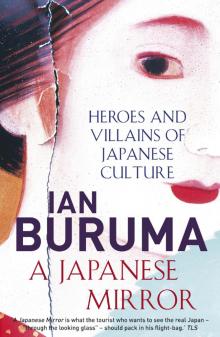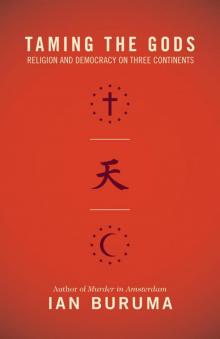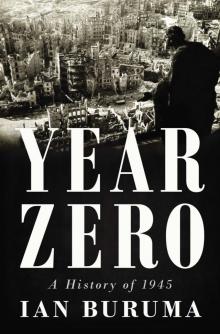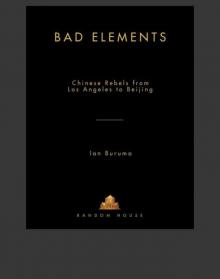- Home
- Ian Buruma
A Japanese Mirror Page 22
A Japanese Mirror Read online
Page 22
With tears in his eyes, Tsuruta plunges his sword deep into his friend’s heart. Covered in blood he rushes down the stairs and meets Wakatomi’s little son (there is nothing like a child to produce the three handkerchiefs). His face is a battlefield of ravaged giri-ninjo emotions as he takes the boy in his bloody arms. Then, and only then does ninjo overcome the last vestiges of gaman. The code of honour has to give way and Tsuruta goes after the villain, who is still officially his senior in the gang, with his sword drawn. The bad man, little toothbrush moustache twitching, pipes: ‘Are you trying to attack me? Where is your sense of honour?’ ‘Sense of honour?’, says Tsuruta, T have no such thing, just think of me as a common murderer.’ And he stabs the evil schemer to death.
It is this sense of shame (haji) that further endears Tsuruta Koji to his fans. Hazukashii (I am ashamed; embarrassed) and sumimasen (I am sorry) must be amongst the most commonly used words in the Japanese vocabulary. Though it is perhaps too simplistic to call Japan a shame culture, as Ruth Benedict has done, shame is certainly a frequent emotion in a people to whom appearances and social face mean so much. But Tsuruta’s shame goes deeper: he is always conscious of individual feelings being oppressed by the very code he stands and falls by. Thus even doing what is socially right can be a shameful thing – killing your own friend, for example.
Tsuruta is ashamed of his very existence. ‘I’m just a worthless gangster’, is one of his favourite phrases. This humility, so different from the swaggering bravado of the super samurai, makes it easier for the audience to identify with the hero. It also adds yet another twist to the giri–ninjo conflict. In ‘Showa Kyokyakuden’11 Tsuruta saves two boys from being killed by a bad group of gangsters. They beg him to exchange saké cups with them as a token of yakuza brotherhood. Tsuruta refuses, not wanting them to ‘belong to the same dregs of society’ as he does.
One of the boys follows him anyway as his faithful disciple. But Tsuruta still refuses to make him a yakuza. When Tsuruta has to go into hiding after killing one of the villains, this disciple is caught and tortured half to death. Tsuruta rushes to the hospital where the boy is dying. The boy’s sister begs Tsuruta to make him a yakuza brother, so that he can die happily. The disciple looks up at his master with tears in his eyes, begging him for this last favour.
What can the hero do? The boy’s loyalty ought to be rewarded, but by making him a yakuza he will die as an outcast. ‘I want him to die with an unpolluted body,’ says Tsuruta, ‘not as a yakuza like me.’ He refuses to grant the boy’s wish. This may seem a little cold-hearted. But to the Japanese audience it is not. By insisting on the purity of his disciple’s death, he shows the highest humanity, as well as his own humility. This is pure ninjo. The giri part is taken care of after the boy dies.
Tsuruta goes off to meet the enemy alone. And he dies too, of course, in the arms of his oyabun, a kindly old man equally ashamed of being a yakuza. His greatest wish is for his daughter to marry a katagi, a ‘straight person’. (Actually she is in love with Tsuruta and vice versa, but out of giri to his boss, he chooses gaman, much to her annoyance; all these feelings remain unspoken, of course.) And so Tsuruta dies, crying ‘Oyabun! Oyabun!’ while his yakuza brothers cry softly, ‘let us be men, let us die like men’.
The final twist of Tsuruta’s giri–ninjo complications has to do with his love-life. Unlike many younger heroes, Tsuruta is something of a womanizer and his emotional entanglements lead to the cruellest bind of all: what to choose? His woman or the group, love or the code of honour? He is both Papageno and Tamino, a most unfortunate condition.
The dilemma is already painfully clear at the beginning of that yakuza classic ‘Jinsei Gekijo’ (‘Theatre of Life’). Tsuruta goes into hiding with his girlfriend, making him useless to his gang. Consequently he is torn between giri to his brothers and love for his girl. Out of sheer guilt – ‘I have to live like a man’ – he dons his best kimono one day and assassinates the rival gang boss.
While he is in prison for this deed, still pining for his woman, she falls in love with Takakura Ken, a former member of Tsuruta’s gang, who has no idea that she is his ‘brother’s’ woman. It all comes out when Tsuruta is finally released. Ken-san goes on his knees, begging Tsuruta’s forgiveness. The girl is torn between the two. Tsuruta, though furious, tells him to go off and take the woman. His gaman and nobility achieve their finest hour.
Now Ken-san is in a bind. What should he do? Be loyal to the yakuza code which would never allow him to live with the woman of a brother? Or should he follow his true feelings? He resolves the conflict in the only possible manner: he goes on a lonely suicide mission to the old rival gang. Tsuruta arrives just in time to hold him in his arms as he dies: ‘Finally you’ve become a man’, he says, and Ken-san dies happily.
Tsuruta, in his turn, knows what to do and as he walks to his certain death, the ballad on the soundtrack swelling, his woman tries to stop him. ‘Get out of the way, woman!’ he shouts. ‘Don’t you see he finally became a man!’
‘But I love you!’
‘I love you too.’
And he pushes her out of his way. Giri must prevail in the world of men, for as the song says: ‘Without giri the world is dark.’ And thus Tsuruta Koji goes on suffering the insufferable, ensuring his popularity by doing so.
Let us pause here to reflect on the connection between the mythical yakuza world and the real one in which most Japanese live. For just as old Hollywood films bore some resemblance to the world for which they were made, yakuza films reflect certain important aspects of Japanese life. In many ways the yakuza world with its giri, its emotional conflicts, and its social suffering, is a stylized microcosm of Japanese society, just as the Kabuki theatre was during the Edo period.
Loyalty to the gang, conflicting with one’s personal feelings; having to choose between the woman one loves and obligation to one’s seniors: these tensions between the individual and his group are still very real. Despite the much vaunted façade of harmony (wa) and consensus, the Japanese are individuals who can, and obviously sometimes do suffer from the grip of collectivity, much though they may need the security of it, just as Tsuruta does. What the yakuza hero represents, more than the swashbuckling samurai, is the loneliness of the Japanese crowd.
‘Salarymen’ are often obliged to sacrifice their private lives for the company. They are frequently compelled to see more of their colleagues – often the only people they see – than their families, whether they want to or not. Human relations on the shop floor are bound by similar restraints of hierarchy and loyalty to those of the cinema yakuza. I was even told by a foreman in a motor-cycle plant that he watches yakuza films to learn how to cope with his job.
An individual in Japan is always part of something larger (the few exceptions are considered to be bizarre loners). The same is true of many occidentals, but they do not identify their ‘selves’ with the companies for which they work to the same extent as Japanese. They have a ‘private life’, which is usually respected. The Japanese do not, or certainly not as much. In fact one only really exists in the context of one’s group. Relationships in these groups are not necessarily based on friendship. Japanese groups, whether they are motor-cycle companies, theatre troupes or yakuza gangs, are more like extended families, with the exception that as soon as one leaves the fold, one ceases to be a member.
For example, a well known avant-garde theatre group recently published a lavish book about its history. There was one peculiar omission: the leading star of the group who had been the major attraction for the last ten years was not mentioned even once. The reason: he had decided to leave the troupe just before the book was written, so he simply did not exist any more. An interesting detail in this story is that the book was edited by one of the country’s leading drama critics. He defended the omission by claiming giri to the group’s director.
Audiences identify with the yakuza hero because he, is essentially a loner. His identity is dependent on his group, which is why he
clings to its symbols. Every conversation, every form of human contact in a yakuza film is another ceremony, another exercise in etiquette to keep the group together. Apart from the occasional outburst of hysteria and the climactic decision to die, every expression of private feelings is stifled by ritual. Yakuza brothers are more like actors going through a series of stylized motions than individual adults behaving as friends. The private human being behind the ritual façade is at all times miserably alone. This is perhaps the human condition of all of us. But without wishing to take the parallel too far, it is, I think, especially true of the human condition in Japan; enough, at any rate, to make Tsuruta Koji and his brothers truly Japanese heroes.
It is a psychological truism that suppressed aggression turns inward. Instead of self-assertive heroes, Japan has many masochistic ones: the more heroes suffer, the more heroic they seem. Macho in Japan is often masochism turned into a fine art. In the case of gangsters this is quite literally so: most of them – in films all of them – sport full body tattoos, painfully carved into their skins from the neck to the knees – and sometimes even to the ankles.12 One can imagine their capacity, indeed their gluttony, for pain.
In one particularly memorable scene a young hero is ordered by his oyabun to work in a street market as a bookseller. To be a merchant is difficult for someone of his temperament and each time he is provoked by a local gang of bullies, he hits back, quite effectively. But this will not do: he is a merchant now and has to learn to take punishment to peddle his wares. (Violence used to be strictly forbidden for merchants in traditional society, for that was the privilege of the samurai class; now the yakuza seem to have taken this traditional role over from the warriors.)
The intemperate young hero is slapped in the face by a senior man in the market place. Chastened by this he learns his lesson. The next time the bullies attack him in the usual Japanese way, all against one, he allows them to beat him up: he is kicked in the groin, punched in the face and knocked half-unconscious. But he is happy, as are the other merchants who gather round him: he has shown his spirit. He has literally been beaten into his proper place in society. And acceptance of one’s social fate is what separates the men from the boys in Japan. This would be hard to imagine in Hollywood, where social mobility and individual assertiveness (‘there is nothing you cannot do if you try’ was the message when Mickey Rooney and Judy Garland put on yet another Broadway show) are traditional ideals.
The all-American hero can never accept the world for what it is; it can always be better; that is what he originally came to America for, after all. The Japanese has no old world, let alone a new one, or even a neighbouring one to compare with his own. Besides, centuries of Buddhist resignation and Tokugawa rule have beaten any illusions of fundamental change out of him long ago. Even the modern Japanese, who often feels a sneaking admiration, tinged perhaps with envy, for American optimism, still finds this attitude childish, and even a trifle barbaric.
Social tragedy, which is in effect what Japanese drama, Kabuki and yakuza, is about, naturally revolves around a closed world from which there is no escape. In the words of the poet Watanabe Takenobu, ‘it is the fate of the yakuza hero to live and die in a closed space’.13 During the Edo period Japanese society was of course literally sealed off from the outside world. This is no longer true, but the mentality has lingered on; the outside world still seems hardly real for many Japanese and for most it is still inconceivable to tear themselves away from their familiar nests. This means putting up with the restrictions of what in many ways is still a closed society.
As popular entertainment clearly shows, this is reassuring as well as tragic. It is reassuring because, as Donald Richie, the film critic, put it, ‘it so clearly defines one’s choice. This seems especially comforting on the stage, or the screen, because this simplification can suggest that there is nothing more than this to life …’14 It is tragic because any attempt to break loose inevitably – in drama, if not always in life – leads to disaster. To quote a character in a yakuza film: ‘There are only two roads for a yakuza, prison and death’.15
For the average citizen real life is not quite this drastic, but too much individualistic behaviour can result in serious ostracism and, even worse, expulsion from the group. The worst punishment for any individual in a traditional Japanese village was just that: mura hachibu, to be sent to Coventry, to be treated as a non-person. To be socially ignored in the tightly knit village community that modern Japan still in many ways resembles is perhaps a fate worse than death – it is, in fact, something like living death.
Being a ceremonial art, as well as a tragic one, the yakuza film depends very much on its symbolism. Without an understanding of its often highly arcane symbols, rituals, manners, the iconography of the tattoos, and the meaning of gestures, it remains inscrutable, rather like Japan itself. All ceremonies are inseparably connected to a specific time and place. Torn from its environment ceremony becomes meaningless. Balinese ritual performed on a stage in London or New York may be a satisfying spectacle, but it loses its significance: it is mere folklore.
In Japan, as elsewhere, common symbols are part of the glue that keeps groups together. The more secret and complex the symbolism, the easier it is to keep outsiders out and insiders in. The penchant of traditional Japanese masters for passing down whatever they have to teach (anything from flower-arranging to classical cuisine) in the form of old mystical secrets, is part of this, as is the old idea that it takes an impossibly long time to perfect the rudiments of one’s art. Although these methods impress a large number of people, Japanese as well as foreign, much of the mystique is simply a device to make people conform to the hierarchy of the group. They also serve, as the great No actor Zeami wrote in 1400,16 to protect the family itself.
But what happens when people are lifted out of their natural habitat, to places where their symbols are not understood and thus fail to impress? One solution, often adopted, is just to pretend one has never left, to hide inside the air-conditioned tour bus, so to speak. Another is to exaggerate the symbols, as if to convince oneself of their validity even in alien territory, to turn them into a parody of themselves: the colonial Englishman wearing tweeds in the tropics or staging – for that is what it was – elaborate picnics in the African bush: ‘Got to keep the standards up, you know.’
The natural habitat of the yakuza film is urban Japan and the time stretches roughly from the end of the last century to the late 1950s. Mythical yakuza do not travel well. This makes the one example of a yakuza film that oversteps its natural boundaries all the more interesting. Both solutions described above are in evidence and they offer a fascinating insight into the mechanics of Japanese nationalism. The film is called, appropriately, ‘Drifters on the Mainland’, starring Tsuruta Koji. It is set in Hong Kong.
The story, briefly, is that a white gang is fighting a Chinese gang for the control of a water reservoir built by the Japanese. Tsuruta arrives to ‘show the Japanese spirit’, as the narrator informs us. This ‘spirit’ is written all over the film. The myth of the yakuza becomes the myth of the Japanese. Tsuruta’s fiancée, in the best Kabuki tradition, sells herself to a brothel to raise money for the Japanese gang. When he protests, she tells him to do his ‘duty as a Japanese – it doesn’t matter what happens to me’.
In any other yakuza film she would have told him to do his duty ‘as a man’; as we have seen, women sacrifice themselves so that their men can be men. He himself would have thought in terms of doing his duty ‘as a yakuza’. Now ‘man’ and ‘yakuza’ have turned into ‘Japanese’: the world of them and us, men and women, yakuza and katagi (straights) has expanded to Japanese and foreigners.
A curious character in the film is a Japanese living in Hong Kong who professes to hate his country, a not infrequent condition of Japanese living abroad. To one who has escaped the narrow confines of the national womb, it can look remarkably like prison. Now this poor man is captured by the villainous white gang and tortured to deat
h. But just before his painful exit he manages to whisper into Tsuruta’s receptive ear: ‘Now I can finally die as a Japanese.’ His dilemma of being an individual human being as well as a Japanese abroad is resolved in death. One is reminded of Tsuruta’s fellow yakuza outcasts crying, ‘let us be like men, let us die like men’. Or even, in a way, of Chikamatsu’s lovers united in double suicide. Only by death can one be granted what proved impossible in life.
Then racialism comes through clearly: the Japanese decide to link arms with the Chinese (whose opinions on the matter are never really considered) to gang up against the white man. ‘The East is one’, says Tsuruta solemnly as he shakes the Chinese boss’s hand. One is tempted to take this as a satire or a parody even of Second World War propaganda, but no, there is no tongue in anybody’s cheek, least of all Tsuruta’s. Nothing could be further from the yakuza – or national – myth than satire. The truth is that wartime myths are by no means dead in Japanese entertainment – neither are they in ours, for that matter. It is surely no coincidence that at the time of writing the same company that produced this film has presented the public with a picture called ‘The Great Japanese Empire’, celebrating among other things, the attack on Pearl Harbour.
Just as the yakuza code, and indeed the codes of most Japanese companies, are based on vague spiritual values, membership of the Japanese race means one can lay claim to the ‘unique’ spirit of Yamato. This is as spurious as the ‘nobility’ of the yakuza, or the Way of the warrior, or indeed similar spiritual claims in other nations, but it is highly potent to its believers.
Being thus privileged, one naturally has the duty to protect others less blessed than oneself: the pure Japanese in Asia must act as true elder brothers to the Chinese and protect them against the evil white man. This is the myth. That this protection in reality meant terrorism does not change the myth at all; neither, after all, does the real yakuza menace to ordinary citizens make them any less noble in the cinema.

 A Japanese Mirror
A Japanese Mirror Taming the Gods
Taming the Gods The China Lover
The China Lover A Tokyo Romance
A Tokyo Romance Theater of Cruelty
Theater of Cruelty Year Zero
Year Zero The Wages of Guilt
The Wages of Guilt Murder in Amsterdam
Murder in Amsterdam Bad Elements
Bad Elements Their Promised Land
Their Promised Land Occidentalism
Occidentalism Anglomania
Anglomania Inventing Japan: 1853-1964 (Modern Library Chronicles)
Inventing Japan: 1853-1964 (Modern Library Chronicles) The Missionary and the Libertine
The Missionary and the Libertine